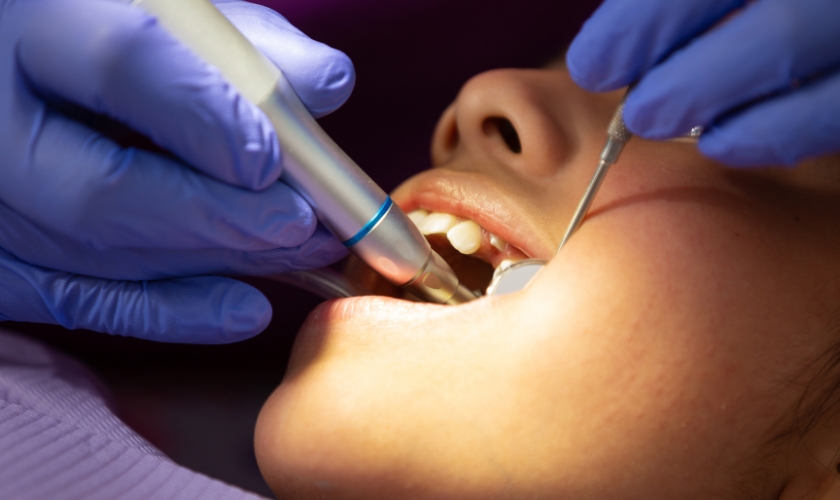
Feeling better after getting a troublesome tooth pulled out can be a big relief. But sometimes, after the extraction, you might get a problem called a dry socket. It’s common and can be really uncomfortable if you don’t take care of it properly. In this blog, we’ll talk about what a dry sockets is, what causes it, and most importantly, how you can stop it from happening and treat it well.
Understanding Dry Socket
When you get a tooth pulled out (tooth extraction), there’s a hole left in the bone where the tooth used to be. Normally, after the tooth is removed, a blood clot forms in this hole. This clot helps protect the bones and nerves underneath while they heal. But sometimes, the clot can come out or not form properly, which causes a problem called a dry socket. It’s also known as alveolar osteitis. This exposes the nerves and bone, making it hurt a lot.
Causes of Dry Socket
Dry sockets can happen for various reasons, all of which can disrupt the healing process after a tooth is removed in Cincinnati, OH. Knowing these reasons can help people take steps to lower their risk of getting this painful problem. Here are the main causes of dry sockets:
- Poor Oral Hygiene: Not keeping the spot where the tooth was removed clean can create a place where infections and problems can happen. If you don’t keep it clean, you’re more likely to get a dry socket.
- Smoking or Using Tobacco: Tobacco products, like cigarettes or chewing tobacco, make it harder for your body to heal. When you smoke after a tooth is removed, it puts bad stuff into your mouth, slows down blood flow, and makes it take longer for a protective blood clot to form, which makes dry sockets more likely.
- Rough Tooth Removal: If the tooth is taken out too hard or rough, it can hurt the area around it and mess up the blood clot that helps it heal properly.
- Past Dry Sockets: People who have had dry sockets before after getting teeth removed are more likely to get them again. This could mean there’s something about their body or teeth that makes dry sockets more likely.
- Medications and Health Problems: Some medicines, like ones that make it harder for your blood to clot, can make it more likely for you to get dry sockets.
- Bacterial Infection: If the spot where the tooth was removed gets infected, it can mess up the blood clot and lead to dry sockets. Not keeping your mouth clean, having a weak immune system, or having other dental infections can make it easier for bacteria to grow and cause problems.
Preventing Dry Socket
Preventing dry sockets after a tooth extraction in Cincinnati, OH is crucial to avoid discomfort and inconvenience. By taking proactive steps and following post-extraction care instructions, individuals can greatly reduce their risk of experiencing this issue.
- Follow Post-Extraction Care Instructions: Your dentist will give you specific instructions on how to take care of the extraction site after the procedure. It’s important to follow these guidelines carefully, including proper oral hygiene practices and any prescribed medications or mouth rinses.
- Avoid Smoking and Tobacco Products: Quitting smoking and avoiding tobacco products is essential for proper healing after tooth extraction. Nicotine and other harmful chemicals in tobacco can narrow blood vessels, which slows down blood flow to the extraction site and makes it harder for a healthy blood clot to form.
- Maintain Good Oral Hygiene: Keeping your mouth clean and free of debris is crucial for preventing infection and promoting healing. Rinse gently with a saltwater solution or the mouthwash recommended by your dentist to reduce the risk of bacterial contamination at the extraction site.
- Limit Physical Activity: Avoiding strenuous physical activity right after tooth extraction is important because it can increase blood flow to the extraction site, possibly dislodging the blood clot and causing a dry socket. Take it easy and avoid heavy lifting or vigorous exercise for the first few days after the extraction to minimize this risk.
Treatment Options
Treating a dry socket involves several steps to alleviate discomfort and promote healing:
- Socket Irrigation: The dentist will gently clean the extraction site to remove debris, food particles, and bacteria, creating a clean environment for healing and reducing the risk of infection.
- Medicated Dressings: A medicated dressing or packing material may be applied to the socket to relieve pain and aid healing. These dressings contain pain-relieving and antimicrobial agents to reduce discomfort and prevent infection while helping form a new blood clot.
- Pain Management: Ibuprofen or acetaminophen can be used to manage pain and inflammation over-the-counter. Stronger pain medication may be prescribed for severe discomfort.
- Antibiotics: If there’s an infection or risk of bacterial growth, antibiotics may be prescribed to control the infection and prevent complications. It’s essential to complete the entire antibiotic course.
- Anti-inflammatory Medications: These medications can reduce swelling and inflammation around the extraction site, helping to ease discomfort and speed up healing.
While dry sockets are preventable with proper care, seeking professional treatment is essential if one occurs. Following your dentist’s advice and maintaining good oral hygiene can minimize the risk of complications after tooth extraction. Remember, your dental health is vital, so don’t hesitate to seek help if needed to ensure a smooth recovery.



